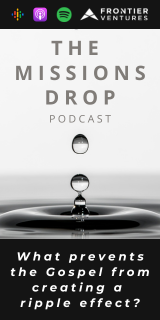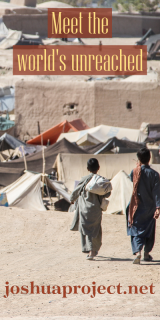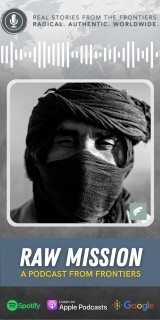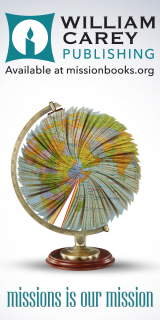Celebrating the Gift of George Patterson
Tributes from those whom he impacted

Only recently I have come to recognize that George had given us far more than a practical methodology. In his simple insistence that local leaders could and should obey Christ, George gave us the heart, soul and center of what a church really is: Christ Himself, obeyed and served by a community of followers. This is also the essential reality of the kingdom of God: people loving, worshipping and serving Christ together, as a new form of life on the earth.
This new life form, alive withthe life of the resurrected Christ, will not only grow, it will multiply and bear the fruit of the Spirit in the local community. The heart of this life is the relational reality of Christ being served, worshipped and loved—or, we could simply say, obeyed. This goal of mission, in Paul’s words, is “the obedience of faith among all the peoples” (Rom. 1:5, 15:18, 16:26).
This relational reality of Christ, and Him obeyed, is why movements (CPM or DMM) actually move. These movements cannot be dismissed as if they were no more than a bundle of gimmicks and tricks to report greater numbers. The great fact is that our Lord is calling people to serve, worship and love Him in every people. Evangelization aims at this hope and goal. Let’s celebrate the gift of George Patterson. He helped us with practical, simple ways to work with our Lord.
—Steve Hawthorne co-editor of Perspectives on the World Christian Movement: A Reader and author of Perspectives on the World Christian Movement Study Guide. He works with WayMakers, a mission and prayer mobilization ministry and helps launch Perspectives courses in strategic settings.
George Patterson was already a veteran in church-planting and church multiplication when I first began writing about Church Planting Movements a quarter century ago. So many of our missionaries have been the beneficiaries of his pioneering work in this field. As he enters heaven, he will undoubtedly be greeted by the thousands upon thousands who have come to faith as a result of his pioneering efforts.
—David Garrison, author of the book, Church Planting Movements and director of Global Gates.
I didn’t know George well, but we were acquaintances and I greatly respected him. In my opinion, his greatest contribution was establishing and popularizing a recognition of the concept of ‘obedience-based discipleship’ which is a critical factor in movement thinking. He also made great nefforts at getting house church approaches used in the USA. While he didn’t have much numerical
fruit in that area, he softened the soil considerably, making it far more possible for the next generation to start making a bit more headway. In terms of tooln development, his “Train & Multiply” materials were (and are) greatly influential. OMS International, and especially their ECC division still utilize these tools widely. Though the tool was developed forn bLatin America, it has since been used to great effect in Africa and Asia as well. That resource was groundbreaking and ahead of its time in many ways. George was a gracious and influential ambassador for the kingdom. He was a humble giant whose legacy will live on in the many people he impacted.
—Curtis Sergeant, CPM trainer and founder of the Zume Project and Metacamp.
George told me: “Mentor, mentor, mentor.” We developed strong coaching for our church-planters, and it has made a huge difference. George’s concept of being “people of yes” (who support and encourage ...) has also been very important for us. And. of course, every church-planter in All Nations can recite, sing and dance to the seven commands of Jesus!
—Pam Arlund, All Nations International
Dr. Patterson’s teaching of The Spontaneous Multiplication of Churches was a favorite of the various lessons in the Perspectives course and probably still is. In the summer of 1987 at the U.S. Center for World Mission, just as the Perspectives class was about to take a break, Dr. Patterson said, “Oh and by the way we are not the ones who are going to complete the Great Commission. I was planning to go to Mongolia at that time and was out of my seat in a shot exclaiming, “What do you mean we’re not the ones who are going to finish the.Great Commission?” Little did I know I had fallen right into Dr. Patterson’s trap and he calmly said, “You ask that question when we come back from the break” and he dismissed the class. After the break, even as the students were still taking their seats, Dr. Patterson was at the front of the class. He looked at me and said, “Now you ask that question again.” So in a much calmer voice I repeated what Dr. Patterson had said and my question. No one in the class had ever heard of near neighbor evangelism. But as George Patterson unpacked this true nd beautiful thesis being one of the keys to the spontaneous multiplication of churches, no one could object. Near neighbor evangelism is simply equipping and releasing believers who are culturally closer to your focused unreached people than you are. These discipled believers will then be the ones to bring the gospel to their unreached neighbors across the river, over the mountain or on the other side of town, etc. These believers are culturally near to the unreached tribe and speak the same trade language they do.
—Rick Leatherwood, veteran missionary in Mongolia and numerous other places
George Patterson helped me move from teacher-classroom-centered training approaches to Paul-Timothy training approaches, which included on- the-job training, on-site and immediate application and follow-up. Thanks George and Denny for getting the mission community back to Jesus’ and the apostle Paul’s effective methods.
—Jean Johnson, Director / Missionary, Five Stones Global
The late Dr. Ralph Winter described George as “one of the two or three world experts in the growth of the church,” and called his missionary career “legendary.” The work of our team in Erdenet, Mongolia and the planting of Mongolia’s first and largest Disciple Making Movement is a testament to the New Testament discoveries of Dr. George Patterson. He trained all of our YWAM team’s primary church planters and it was his teaching and article in the course Perspectives on the World Christian Movement that launched my own career into multiplicative church planting. Very little in the content of my trainings over the past 20 years is original—most of what I teach is simply an echoing of George and what I have learned through putting his “Obedience Oriented Education” into practice among unreached people groups. All of us in YWAM’s Frontier Missions look to him as mentor and “Guru George.” I am blessed to have had as my friend!
—Brian Hogan, YWAM Church Planting Coach, Perspectives and mission speaker, publisher, and author of There’s a Sheep in my Bathtub: Birth of a Mongolian Church Planting Movement, An A to Z of Near-Death Adventures, and Boy Centurions.
Fifteen years ago, I was an ambitious, high performing leader in the American church system. But I felt empty. Although I’d been relatively “successful”—raising money, recruiting staff, gaining an increasingly large following, etc., I didn’t feel like I was actually following Jesus.That year, I stumbled into a training taught by an elderly man who seemed to bounce around the room like Tigger from Winnie the Pooh. His name was George Patterson. He taught in a way I’d never seen anyone teach. His enthusiasm was virally contagious. He emanated an attitude of playfulness as he taught about the Great Commission and how to create disciple-making relationships and form churches that can multiply virally. He gathered us into groups to create skits to illustrate his principles. Of course, he never claimed these were his principles—he simply said he was lowering the bar about training to get back to the basics of how Jesus and the Apostles formed disciple-making relationships and churches. We didn’t fill out massive volumes of notebooks. It felt like the 30 people in the room were playing together as we rediscovered the Great Commission. I was blown away, not only by the way George taught—so different from conventional lecture styles I was used to, but by his concepts about church and disciple-making multiplication that so much more clearly seemed to reflect the way of Jesus and the strategies of the Apostles in the Book of Acts. My heart was gripped. But my mind was filled with questions. These Church Planting Movements George talked about were occurring in Unreached People Groups—far removed both geographically and culturally from the context in which I worked here in America. I approached George during a break. “Dr. Patterson, is it possible to see one of these things you call a CPM in the Western World?” He looked at me, pausing for what seemed like theatrical, reflective effect, and replied, “Hmmm. Well, that depends. How willing are you to abandon everything you’ve learned about American models of planting churches and return to a biblical model of making disciples?” Seeking to go on a new adventure with Jesus across the U.S. and find more effective ways of creating communities of disciples among pre-Christians, I’d just resigned from my job as a pastor on staff at a church. I’d lost most of myfriends in the process. Having not much else to lose, I replied, “I’m willing to try anything.”
He responded with his “Tigger” type bounce again. He became exuberant. In a high-pitched voice, he said, “Then it’s totally possible!” George began a mentoring relationship with me that day. He was a master at coming alongside creative, messy, misfit leaders like myself and guiding them to go out and dare to do something spectacularly fruitful for the kingdom of God, simply by obeying Jesus, learning from New Testament examples, and avoiding the pitfalls of modern church traditions that don’t adhere to the model of Jesus and the Apostles. The fingerprints and DNA of George Patterson have been reflected through my life ever since. Church Planting Movements are possible in the Western World. I’ve experienced it. I’ve reproduced those unforgettable skits George led that day (Extraction Evangelism, Great Commission relay race, etc.) and taught George’s principles of the Basic Commands of Jesus and the Three Levels of authority for the last 15 years. I pray we can all be more like George—willing to offer ourselves as mentors to movement makers and givepermission to next generation leaders who dream of seeing both spiritual awakening and reformation of culture by simply obeying Jesus.
—Erik Fish, Global Disciple Making Movement Catalyst, All Nations, ErikFish.com, Mentor Leaders: Multiply Movements
George Patterson practiced the principles that he taught to others: “You cannot predict who will be successful, so mentor those who are willing to learn and to put their learning into practice. When you mentor those who start or lead new little churches, listen carefully to their reports, to learn their churches’ urgent needs. Then plan with them what they will do in their churches, immediately, to meet those needs. Give them something to read that suits their educational level. If they were unable to implement their plans, then you probably gave them too much, so make new plans. Always pray with them, by name, for those whom they mentor, in turn.”
—Galen Currah, DMiss, long-time friend and colleague of George Patterson
My beloved mentor George Patterson has gone into the presence of Jesus. I feel sad but also have a sense of joyfulness. We know George is with the One he lived his life for. We will see George again, but he leaves an empty spot in our lives. Lives which he
changed through his faith in God and in us, his wisdom gained through experience, his energetic enthusiasm, constant encouragement, practical love and practical jokes. As one of George’s interns in1986, one of my projects was to help him with his book: The Church Planting Guide. I told him all of this was new to me and wondered how I could possibly be of any assistance to him. He excitedly told me that I was his target audience and if I could understand it, anybody could. Many years later I wrote a very simple illustrated book: Keys to Church Planting Movements using much of what I learned from George and the experiences of training others in these principles. George graciously wrote the foreword. Currently I am working on writing a story of the various, practical ways George mentored me. It will be posted on ywamfm.org.
—Kevin Sutter, International Director of YWAM Frontier Missions
—Jackie, YWAM FM working with an unreached tribe in Philippine mountains
There was today in heaven an enormous welcoming home party for a great servant of God—Dr. George Patterson! His passion for
the lost and “simple church” was contagious! He was one of the fathers of modern-day CPMs on discipleship principles. He always stressed simplicity, reproducibility and obedience to Christ’s commands. Sacrifice and persecution were part of the package of planting churches where the kingdom of God was not yet. What a privilege to have been able to learn from him and by applying the principles he taught see the Father’s House movement among Iranians and Afghans start.
—Willem, YWAM FM launched a DMM among Muslim refugees
George had a tremendous influence on the YWAM FM family in the 80s. I’ll always remember him for his passion and how he invested so much into the FM leaders in those formative years. His focus on keeping things simple and reproducible still guides my thinking in almost everything I do. Discipling new believers by training them to walk in obedience to the 7 commands of Christ continues to be a simple yet profound discipling strategy. We are grateful for a life so well lived and we can follow his example as we continue on our journey of being disciple-makers.
—Kevin Stabler, YWAM FM, worked for 25 years among a tribe in the upper Amazon
—Rex G
—Meredith Johnson, All Nations
Every training I lead, every class I teach, every book and article I’ve written all have George Patterson’s fingerprints all over. “There are literally millions of people around the world who have never heard of Dr. George Patterson, and yet have been discipled and/or trained as a follower of Jesus because of his work.”








comments